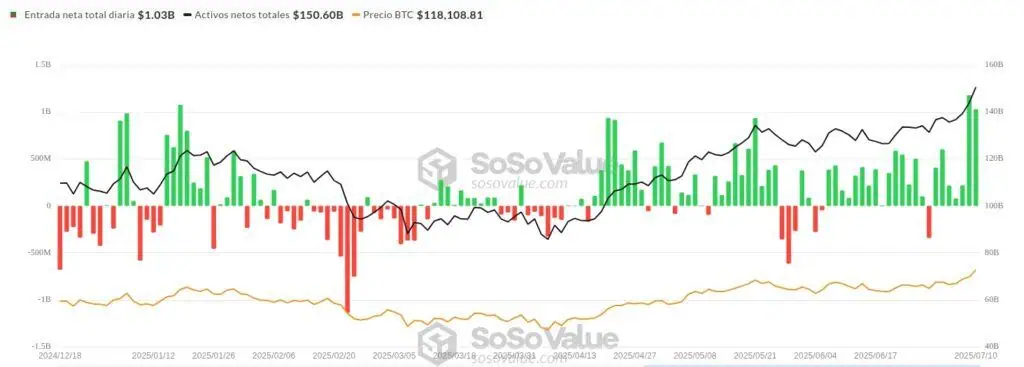
According to experts, Bitcoin is showing clear signs of financial maturity: lower volatility, price consolidation, and strong institutional participation. This shift suggests more stable and attractive growth for long-term investors.
Bitcoin, historically known for its extreme volatility, is moving away from the unpredictable digital asset that dominated headlines for its explosive rises and abrupt falls.
This 2025, the most recognized and capitalized cryptocurrency in the world is showing clear signs of financial maturityAccording to experts, realized volatility—a metric that measures historical changes in BTC's price—has dropped dramatically from levels close to 100% in 2021 to stabilize at around 29-30% currently. For many, this change not only means price movements are less abrupt, but also allows investors to more accurately anticipate the behavior of the leading cryptocurrency.
BUY BITCOIN ON BIT2MEBitcoin matures: less volatility, more stability
The current price of Bitcoin, which remains stable around $120.000 dollars, reflects a phase of stability supported by solid fundamentals. Unlike previous cycles, where increases were rapid and followed by equally violent corrections, Bitcoin's growth now appears slower, but also more sustainable.
In the last week, Bitcoin has gone from trading at $108.000 to a new all-time high. (ATH) of $123.091 dollars, on July 14. This represents a weekly increase of 12%. Bitcoin has risen 16% in the last month, and 100% in the last year.

Source: CoinGecko
In previous cycles, especially after halving events such as the one in April 2024, Bitcoin's price increases have been markedly more volatile and abrupt. After the July 2016 halving, Bitcoin went from trading around $600 to reaching an all-time high of $19.834 in December 2017. This annual growth of more than 3.000% This occurred in an environment dominated by retail investors, with little institutional infrastructure and a nascent derivatives market. The volatility was extreme, with the BTC price dropping more than 30% in a matter of days at various points.
Likewise, in 2020, after the halving in May of that yearBitcoin began a new bullish phase that took it from $8.600 to over $64.000 in April 2021. Although the market was already seeing greater institutional participation, volatility remained high. In May of that same year, Bitcoin fell more than 50% in just a few weeks, affected by factors such as China's restrictions on cryptocurrencies and Elon Musk's statements about Bitcoin payments at Tesla. Realized volatility reached levels close to 90%, reflecting a still speculative environment.
Therefore, the current price performance of Bitcoin is attracting a different type of investor, one that's less speculative and more institutional.
BUY AND MANAGE BITCOIN ON BIT2MEETFs and institutional capital: Bitcoin's new driving force
One of the key factors behind this transformation is the massive influx of institutional capital. Bitcoin spot ETFs have been key players in this process. In July 2025, a year and a half after their approval in the United States, they were registered entries exceeding $1.000 billion dollars in these funds, led by financial giants such as BlackRock and Fidelity. This injection of liquidity has helped stabilize the market, reducing dependence on retail demand and cushioning the effects of speculation.

Source: Soso Value
But institutional interest is not limited to ETFs. Firms such as Strategy and Metaplanet have bolstered their Bitcoin positions as part of their treasury strategies, consolidating its role as a reserve asset. Furthermore, pension and sovereign funds are beginning to include Bitcoin in their portfolios, suggesting a growing acceptance of the asset in traditionally conservative financial circles.
This type of participation not only provides volume but also discipline. Institutional investment decisions are typically based on rigorous analysis and long-term horizons, which reduces the likelihood of impulsive movements and contributes to price stability.
Derivatives and options: sophistication in risk management
The growth of the Bitcoin derivatives market is another indicator of maturity, according to experts. In the first half of 2025, open interest in derivatives exceeded $70.000 billion. It currently exceeds $82.000 billion, reaching new all-time highs.

Source: coinglass
Sophisticated traders are using options to build more complex strategies, such as selling implied volatility. These trades cushion sudden price movements, reducing risk exposure and contributing to a more orderly market. Furthermore, the use of derivatives as hedging tools is gaining ground, indicating a more strategic approach to the digital asset.
The leverage structure has also improved. After episodes of massive liquidations in previous cycles, current margins are healthier and positions more prudent, reducing systemic risk and strengthening the resilience of the crypto market.
BUY BITCOIN FAST AND SAFEWhat to expect in the coming months?
Although Bitcoin's volatility has decreased, analysts warn that the possibility of episodes of high volatility cannot be ruled out. Macroeconomic events, regulatory decisions, or unexpected movements by large holders could temporarily alter the cryptocurrency's current stability. However, the fundamentals appear solid.
Some technical models suggest that a new wave of appreciation could occur by the end of 2025, especially if the flow of institutional capital continues and regulatory progress in the United States is consolidated. The approval of new laws, such as the CLARITY Act and the GENIUS Act, which will be debated this week in the so-called Congressional Cryptocurrency Week, could further strengthen Bitcoin's legitimacy as a financial asset.
In this context, Bitcoin is moving beyond its highly speculative asset phase to become an increasingly mature financial tool. Its evolution benefits not only institutional investors but also retail investors seeking predictability and lower risk exposure.

Cryptocurrency Technical Analysis Course
Medium levelIn this training we have Iván González, a professional expert in investments and cryptocurrencies, to teach you how the market works and how prices affect the behavior of investors.



